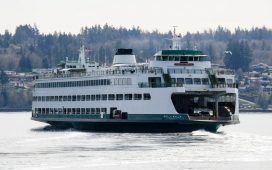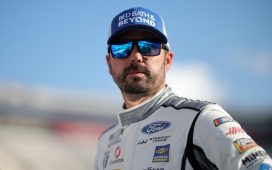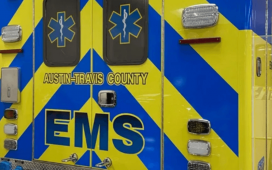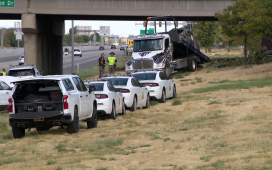The transportation planning world has had various bogeymans — unsafe streets, urban highways, and lately Project 2025. The latter is a report officially called “Mandate for Leadership: The Conservative Promise” published by the Heritage Foundation, a famous conservative think tank in the United States. The document has a detailed plan, to “save” America, touching all areas in our society — which, of course, includes transportation. But do not let the name hinder its content, as a simple reading of its ideas will reveal concerning issues.
Project 2025 puts public transit funding at risk
The report proposes various plans with very questionable arguments. For instance, one of the most notable proposals is to limit or cut funding for mass transit. Chapter 19 of the report, which is dedicated to all things transportation, proposes to abolish the Federal Transit Administration’s Capital Investment Grants (CIG) program. An article published by the Center for American Progress does a great job analyzing what this would mean for our nation; in their words the proposals on Project 2025 “could devastate local transit systems, hurt families, and undermine economic growth,” cutting off billions of federal dollars to major transit agencies such as the Metropolitan Transportation Authority in New York City or the other 2,147 active transit agencies that also receive funding from the Federal Transit Administration.
The attack on America’s transit does not stop there. The paper blames investments in transit for the Highway Trust Fund’s insolvency. Consequently, proposing to cut transit from the Trust Fund.
This is problematic for two reasons. The first is the belief that transit should provide profit, like a business. The key difference is that mass transit is not a business; it is a public good that provides enormous benefits. This can be seen in the way funding is provided. The funding for transit is given through various core programs such as the “Congestion Mitigation and Air Quality Improvement Program,” which provides funding for projects that may reduce emissions of transportation-related air pollutants, or the “Promoting Resilient Operations for Transformative, Efficient, and Cost-saving Transportation (PROTECT formula program),” which provides funding for transportation infrastructure resiliency projects. Mass transit checks all these boxes, making it a single solution for various issues.
It is also important to note that highways are not the prodigal son in our transportation system, as the government also subsidizes roads. According to a report by the Frontier Group, “Since 1947, the amount of money spent on highways, roads and streets has exceeded the amount raised through gasoline taxes and other so-called ‘user fees’ by $600 billion (2005 dollars).” The big bucks are spent to save highways (that can’t seem to pay for themselves either), but the authors do not seem to care. This shows a double standard. Roads can’t pay for themselves but transit always should? The authors also don’t account for a key difference: transit is better for public health, and efficiency, and takes vehicles off the road by promoting a more sustainable mode of transportation at a time when climate change is looming. Transit makes America’s big metropolises work and makes communities more resilient.
Before we get to the second point, some context on how the Trust Fund budget is organized is necessary. The Trust Fund has two main accounting mechanisms: the highway and the transit account. Historically, the transit portion has always been smaller than the highway portion, specifically 4 to 1 (even though, in practice, it receives even less than that). For instance, for the year 2022, the total revenue of the Trust Fund was $48 billion. From this amount, $42 billion went to the highway account and $6 billion to the transit account (a ratio of 7 to 1).
According to a publication from the Peter G. Peterson Foundation, a nonpartisan organization dedicated to addressing America’s long-term fiscal challenges by 2034, the Trust Fund will be in a deficit of $280 billion. Hence, let’s say we took transit out of the budget (and for calculation purposes, we are going to assume each year $6 billion on transit is spent), that would mean that by 2034 there would still be a $220 billion deficit left.
This means that even if we take transit spending from the budget, most of the deficit would still be there, but millions of Americans would be negatively affected by the lack of funding for transit.
If the Project 2025 authors would like to actually help solve the deficit, they should look at something more problematic: the fact that the federal gas tax has not kept up with inflation. Since 1993, the gas tax has not been raised from 18.4 cents a gallon. If the gas tax had kept up with inflation it would almost be around 40 cents a gallon, and if we take into consideration that 80 percent of the Highways Trust Fund comes from the gas tax, then a big shortfall can be discovered. According to the Congressional Research Service (CRS), a single penny added to the federal gas tax would provide the trust fund between $1.7 billion and $1.8 billion a year.
Once again, motorists are not paying their fair share, yet transit is still to blame? It is also important to note that, as more vehicles abandon fossil fuels as their main energy source, the gas tax will stop being effective and a new way of funding the trust fund will be needed. For example, a great one is a vehicle miles traveled (or VMT) tax, which would charge all vehicles for their travel, regardless of the energy source.
Project 2025 calls for end to efforts to make roads safer and reunite communities
The paper also highlights the need to stop recent goals set by the Federal Highway Administration (FHWA). It calls for the abolishment of Vision Zero as federal policy, calling it a Biden administration tactic to cause congestion for automobiles. It also argues to stop equity goals, saying it is a “nebulous concept” and that both Vision Zero and this are only “goals of progressive activists” and implying they are both not “practical goals.” That is simply untrue. In 2022, there were 42,514 deaths from motor vehicle crashes. Policies such as Vision Zero recognize that a significant portion of these are preventable and that traffic-related deaths are not a fact of life.
Calling reducing traffic deaths a non-practical goal is insulting to the hundreds of thousands of families who have lost someone because of mistakes that could have easily been fixed with basic traffic calming measures. While Vision Zero sometimes reduces speeds, it is not done at the expense of inconveniencing motorists, but rather for the sake of saving lives, which far outweighs any five- or ten-minute delay in a motorist’s commute.
Additionally, the abolition of equity goals would not be concerning if the country’s past were not so problematic. But the built environment is long-lived, and any action made 50 or 70 years ago is still alive and well today. Practices such as redlining or the highways constructed in the name of urban renewal that displaced and destroyed minority communities might not be legal now, but their effects are still clearly felt in communities today.
The Bipartisan Infrastructure Law (BIL) passed under the Biden Administration in 2021 included plans such as the Reconnecting Communities Pilot (RCP) Program, which aims to fix mistakes from the past by reversing transportation policies that were used to divide communities, emphasizing principles of equity and justice in our system. For the fiscal year of 2023, the program has provided hundreds of millions of dollars of financial support to more than 130 communities across the country. The BIL has also provided the resources for the creation of the Safe Streets and Roads for All (SS4A) program which provides, for five years, billions of dollars to address the rise of preventable deaths in our nation and improve safety on our roads. The program so far has been a success, with funds provided to hundreds of communities across all U.S. and Puerto Rico — with half of the funds specifically benefiting underserved communities.
Calling for the abolition of equity and Vision Zero goals could endanger programs like these, taking us backward and keeping our communities divided and our roads lethal. Ignoring these issues, which is what the authors of chapter 2019 of the Mandate document are trying to do, will not change the past (or present), and will only create a future where our communities are still damaged.
Project 2025 says no to more fuel efficient vehicles
The paper also critiques Corporate Average Fuel Economy standards and new calls by the Biden Administration to increase fuel economy requirements. It calls them unrealistic goals for most internal combustion engine automakers and calls for loosening the standards.
When arguing for this, the authors suddenly comically care about traffic deaths and air pollution (despite clear efforts to abolish programs such as Vision Zero and Reconnecting Communities), blaming CAFE standards for the rise in traffic deaths, arguing that increased vehicle prices — caused by fuel efficiency requirements — have forced people to drive older, less safe cars. In reality, roads have become more dangerous because of the continued investment in car-dependent infrastructure, making our country’s roads into hostile environments (even for people inside other motor vehicles). The bigger issue here is not older vehicles, but car dependency and road designs that prioritize speed over human safety.
Our roads are also dangerous because of a loophole exploited by automakers inside CAFE standards. Originally CAFE standards worked as intended, but automakers found a way to avoid these restrictions.
CAFE standards required vehicles to gradually increase fuel efficiency annually, yet at the time there was a big push from car lobbyists that SUVs and trucks should have less stringent restrictions than sedans and station wagons. Back then (1970s), SUVs and trucks represented less than a quarter of new cars sold; hence, it did not seem like a big issue. However, automakers took advantage of this by producing larger, heavier cars — often SUVs and trucks — that could bypass these regulations, which in turn made roads more dangerous.
If the Project 2025 authors really cared about road safety and air pollution it would call for the correction of this loophole, finally obligating automakers to properly comply with the standards and to invest and support Vision Zero and transportation equity-related policies. It would not idolize ICE-powered vehicles — fantasizing about some sort of utopian future in which we still use highly polluting finite resources such as fossil fuels. Loosening CAFE standards would be a step in the wrong direction. Controlling emissions is still primordial to our climate goals, and further investing in outdated technologies will set us back on the path of a leading nation in a changing future.
Project 2025 is bad for the future of America’s transportation system
Clearly Project 2025’s authors envision a future where car usage is nonbothered and prioritized over all forms. A future where road users are not equal but rather ranked by their ability to own a motor vehicle or stand out of a motorist’s way. A future where the safety of vulnerable road users is considered impractical and where the mistakes of the past remain uncorrected. They also envision a future in which we are still dependent on fossil fuels, ignoring the looming threat of climate change.
Despite the fact that former president Donald Trump has tried to distance himself from Project 2025, this document is still relevant to current politics and has a big influence in the national conversation. It is favored and developed by various members of the conservative party (including many of Trump’s closest policy advisers, people who would likely have high-ranking positions in a future conservative administration, regardless of the outcome of the 2024 election), which makes its possible future impact still a possibility.
As working professionals in the transportation industry, citizen advocates, or anyone interested in the future of America’s transportation system, we need to make sure to protect it, and ensure its future is not deterred by backward,misguided policies that will destroy the progress of the last few decades.







